There are some fixtures in football that have a habit of producing memorable encounters. Following the infamous Battle of the Bridge in 2016, Tottenham‘s 4-1 home defeat to Chelsea last week was another classic. However, it wasn’t so much a battle this time but Lunacy at the Lane.
There were plenty of talking points for a match where the ball was only in play for 43% of the time – the lowest percentage of any Premier League game in the last two seasons.
As well as the five goals that stood, five were disallowed. Spurs were reduced to 10 men in the 33rd minute when Cristian Romero brought down Enzo Fernandez in the penalty area. Cole Palmer converted the spot kick to equalise, and Tottenham’s night got worse in the 55th minute when Destiny Udogie received his second yellow of the game. The Italian was fortunate not to have been dismissed earlier after a two-footed challenge.
Despite the numerical disadvantage, Spurs boss Ange Postecoglou favoured an attacking approach that saw his side adopt a high line to the final whistle. Whilst some pundits have applauded the brave tactics, others have been critical, stating that the Australian should have ordered his players to shut up shop.
In this tactical analysis and tactical theory piece, we will provide an analysis of the different approaches adopted by different teams to being reduced to 10 men or more. We will explore the tactics adopted and the subsequent outcomes to determine the advantages and disadvantages of the varying approaches.
Postecoglou sticks to his principles
Since Postecoglou took charge in North London, Spurs have showcased attacking flair, winning the plaudits. Their style of playing out from the back, transitioning attacking play in each third of the pitch has paid dividends as they lie fourth in the Premier League.
One of their main strengths this season has been their high press, and they currently have the lowest PPDA value, at 9.2, in the division. This is an indication of how successful their pressing has been. Despite the positive approach the Australian has incorporated at White Hart Lane, Spurs would have been forgiven for deserting their original gameplan when they went down to nine men against Chelsea.
However, Spurs went ahead, playing an extremely high line for the remainder of the game.
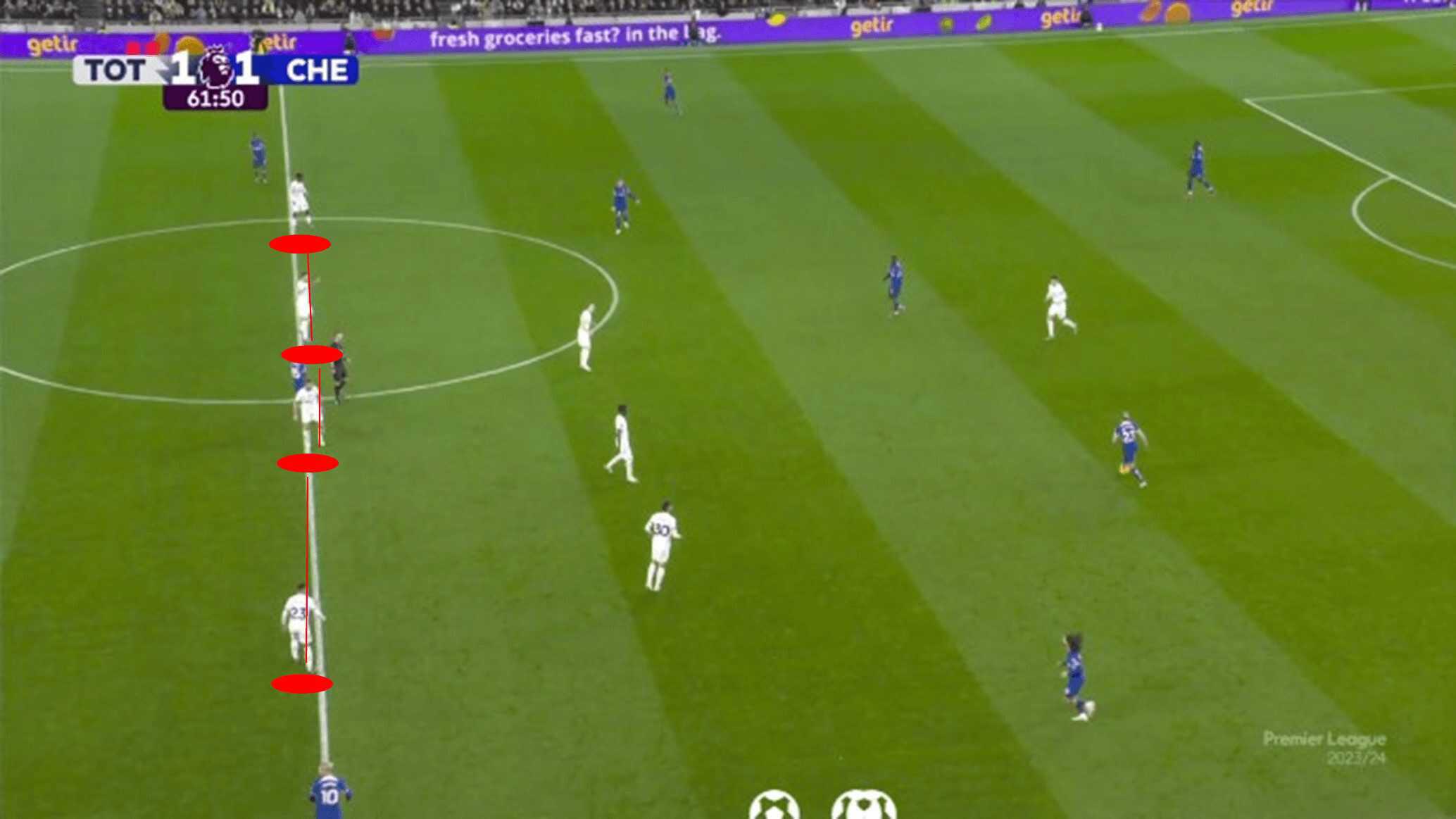
Spurs’ line often set up near the halfway line, attempting to catch Chelsea offside. The surprising tactic actually worked to good effect as the Blues were caught offside seven times throughout the match. Chelsea continuously struggled, and the linesman’s flag continued to intervene with the Blues attacking phase of play.
The high line effectively condenses the opposition’s space and restricts them from playing long balls or through balls. Tottenham were further able to make use of this tactic due to the qualities of their goalkeeper, Guglielmo Vicario.
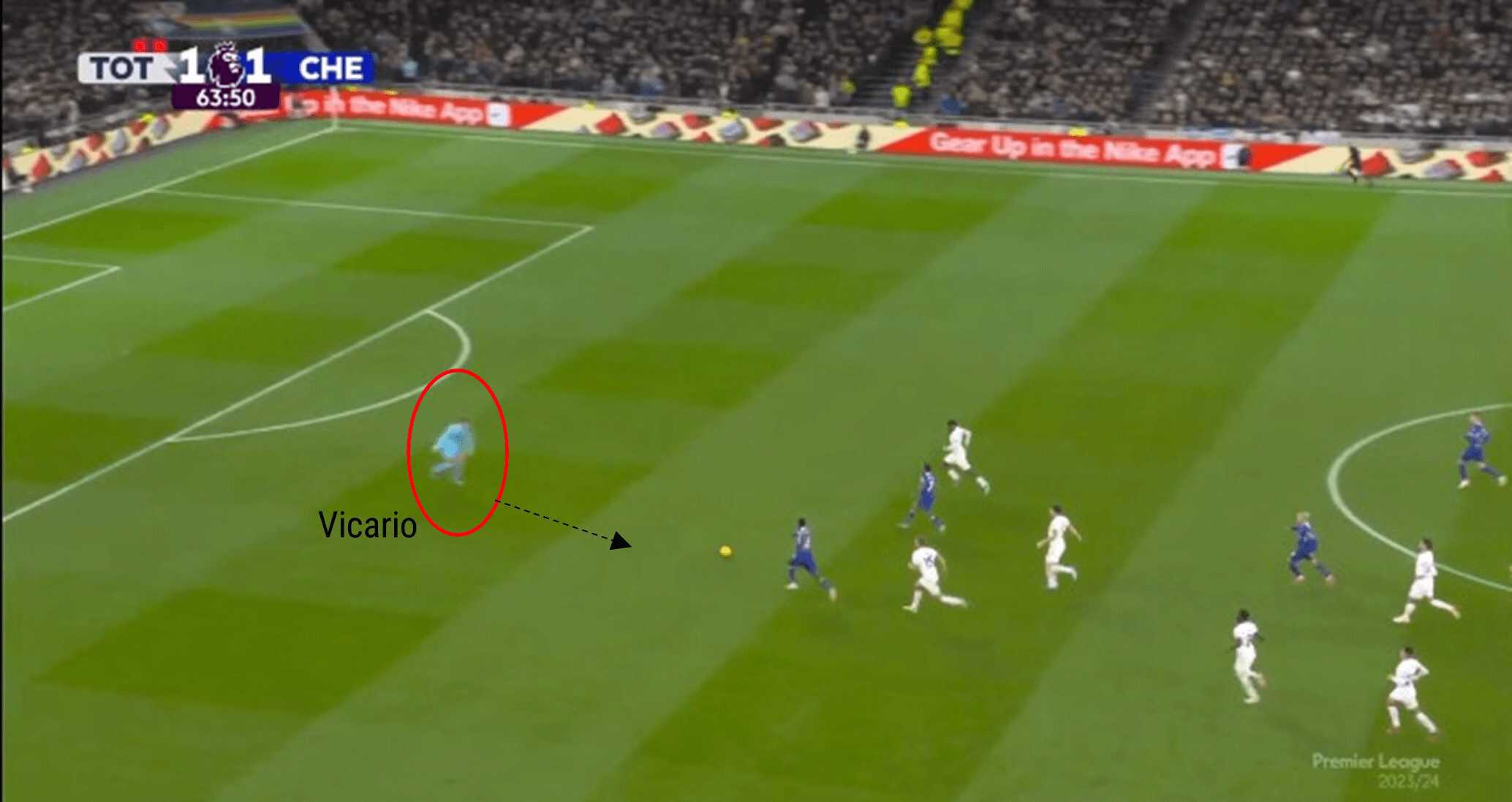
Vicario is seen here advancing from his penalty area in a bid to retrieve the ball ahead of the oncoming Chelsea forward, Nicolas Jackson. The Italian goalkeeper does get to the ball first to clear the danger. He frequently made actions like this during the match.
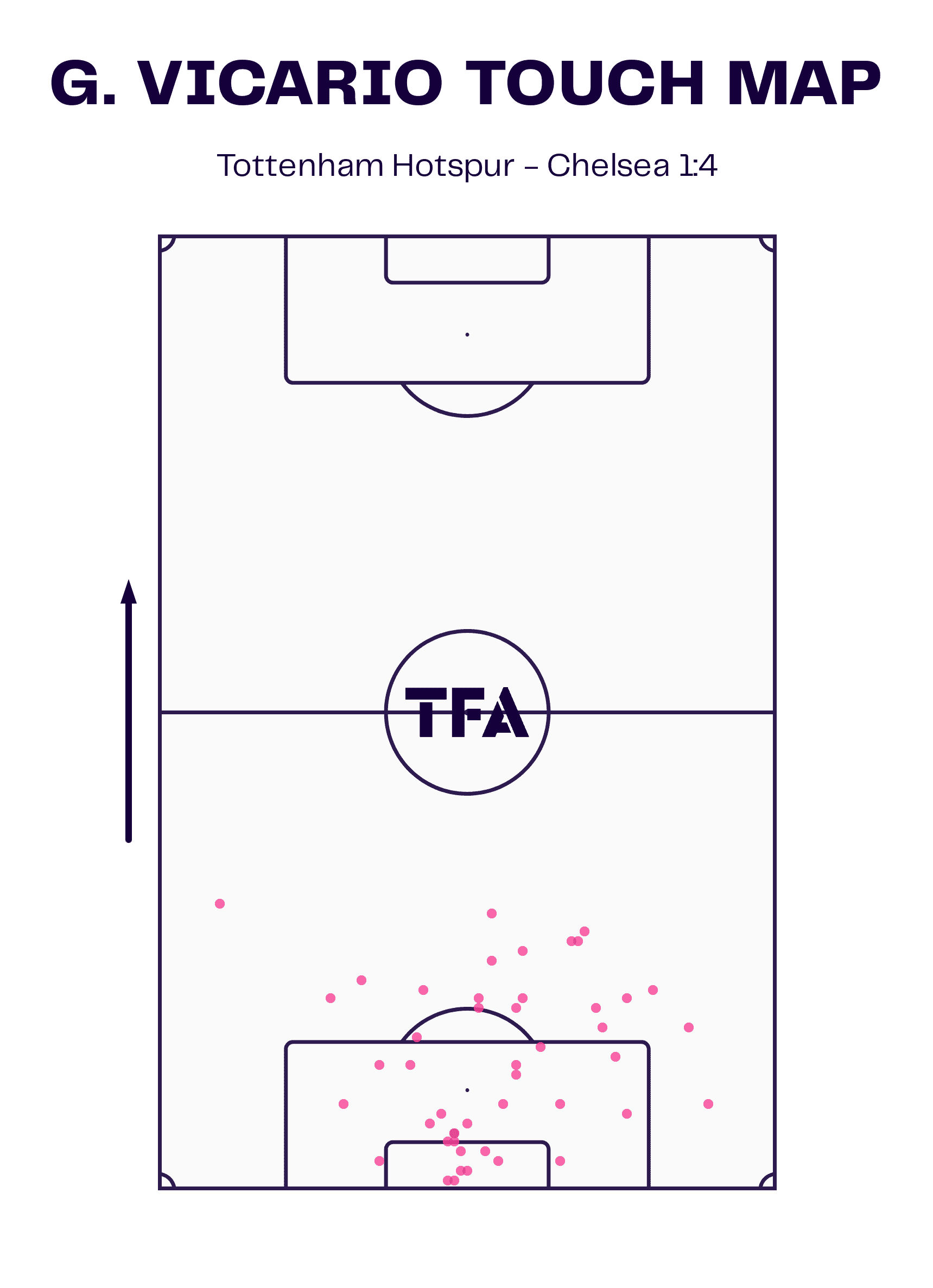
The graphic shows the touches by Vicario during the match, and it is noticeable some touches were a considerable distance from his goal line. Vicario was the definition of a sweeper keeper during the encounter, as he made 12 defensive actions outside his penalty area. Vicario has excelled in such sweeper actions this season and has made 2.83 defensive actions outside the penalty area per 90 this season, the highest of any goalkeeper in the league this campaign.
Spurs will have had confidence in playing so high, given the attributes of Vicario, and they nearly earned a point had Eric Dier’s volley following a set piece not been ruled out for offside. Eventually, though 20 minutes from Udogie’s dismissal, Chelsea found a way through the Spurs backline and went on to win the game.
One of the issues in playing a high line is that the defence can be caught out if they lack pace. This was the case with the Spurs centre-back pairing at the time. However, considering it took Chelsea 20 minutes to make the breakthrough finally, Tottenham may have been able to get something out of the game had the red cards occurred later in the match. Therefore, there is an argument that attacking principles can still be implemented despite a disadvantage in numbers.
When fortune favours the brave
In Union Berlin’s second Bundesliga match of this campaign against Darmstadt, they ran out 4-1 winners. The scoreline is made more impressive by the fact Union Berlin were reduced to 10 men in the 21st minute following Brenden Aaronson’s second yellow card.
Union Berlin started the match in a 3-5-2 formation and took the lead in the 4th minute. They refrained from making any substitutions following Aaronsen’s dismissal, but Darmstadt soon equalised. It was this equaliser that prompted a change by Urs Fischer, sacrificing forward David Fofana in favour of Sheraldo Becker in midfield. The move restored Die Eisernen’s numbers in the central areas.
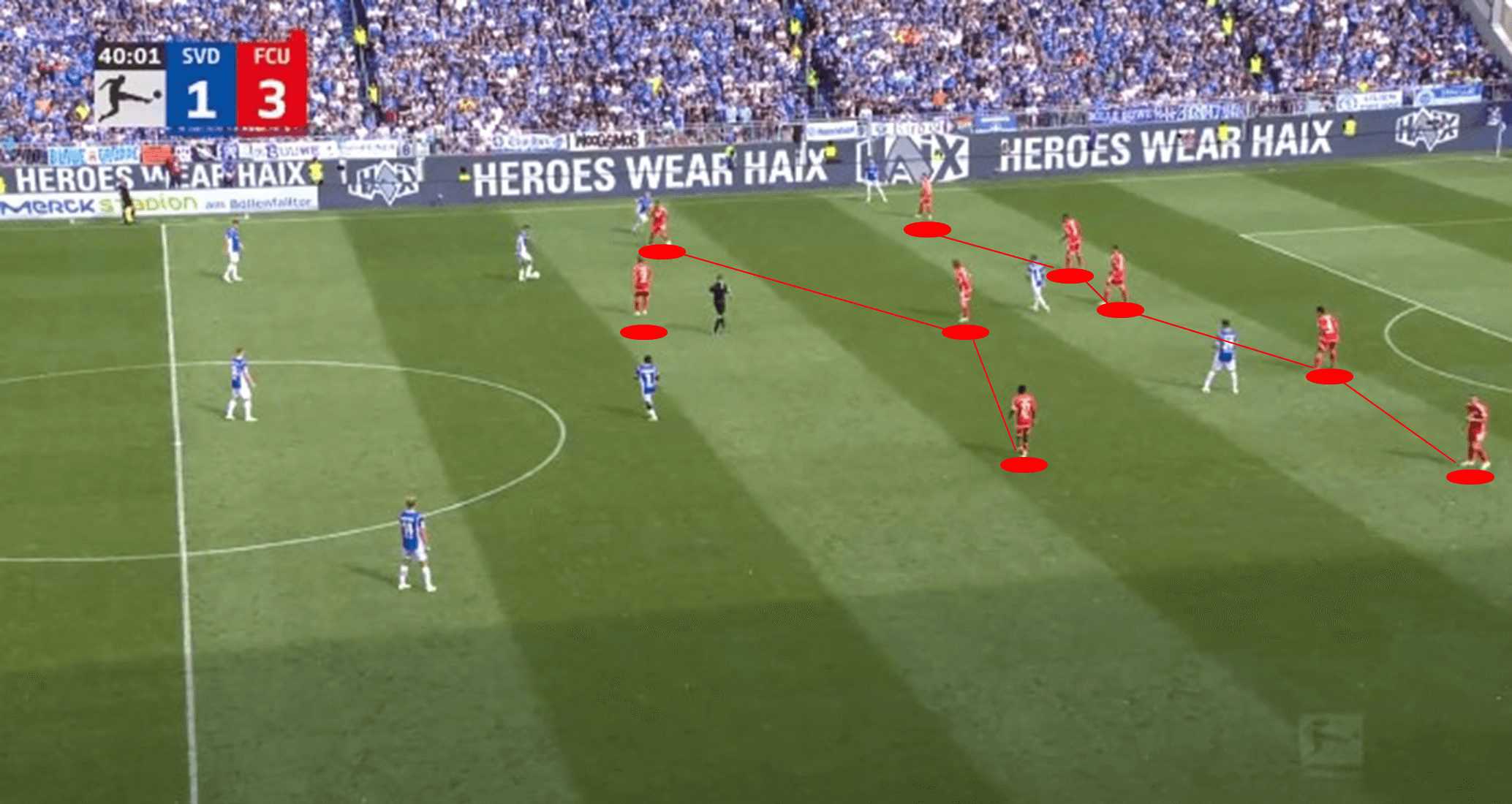
When out of possession, Union Berlin adopted a 5-3-1 formation. Playing five at the back made the German outfit a difficult side to break down; the three in midfield ensured a compact defensive shape centrally.
However, with the ball, Union Berlin were not afraid of committing players forward in the attacking transitions.
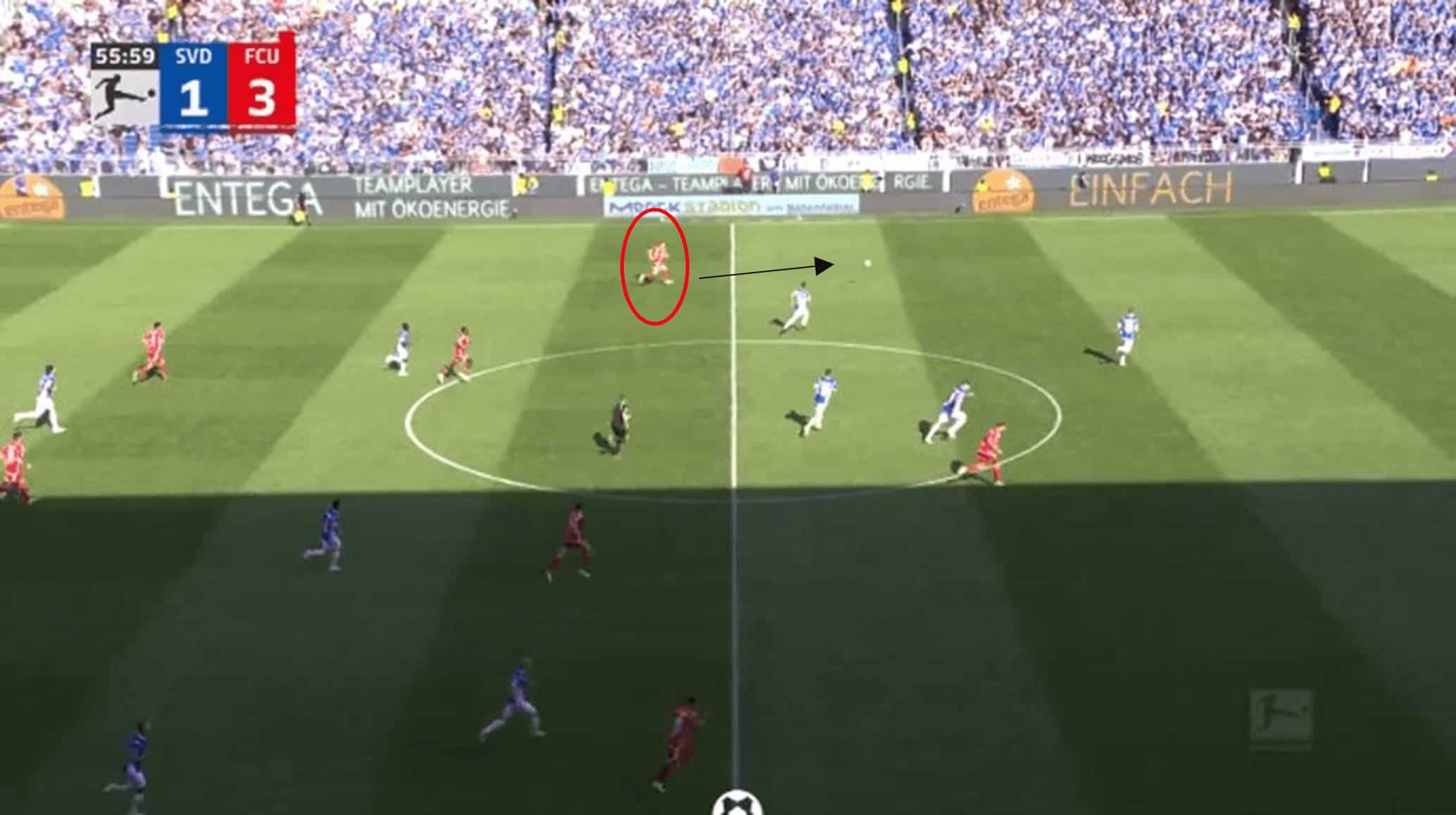
The match still shows an advancing Robin Gosens running onto the ball, which has been distributed out wide. Gosens was able to provide an attacking outlet for his side as well as his defensive duties.

The heatmap testifies the attacking positions Gosens took up during the game. The heatmap further shows how the right wing-back, Josip Juranovic, also provided a threat in more advanced positions. The two Union Berlin players were crucial in providing width for their side.
An advantage of incorporating attacking players when subject to numerical disadvantage is that pressure is still applied to the opposition’s defence. Union Berlin made plenty of chances against Darmstadt with a positive approach.
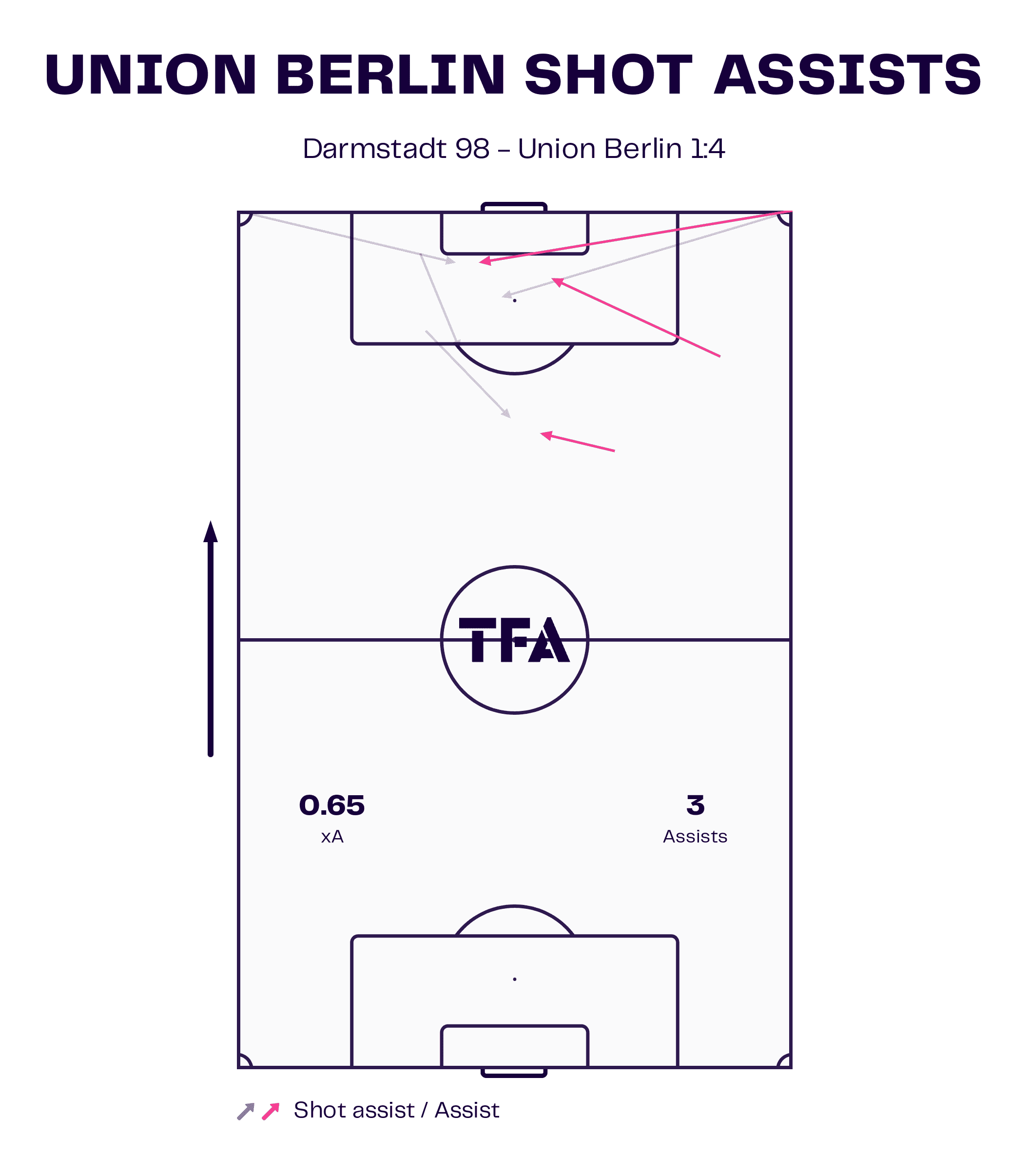
The graphic shows that Union Berlin were particularly effective with their corners. They actually scored three goals when down to 10 men from set pieces. This suggests the value of set-piece opportunities when playing with fewer players than your opponent, as it represents an opportunity to get men in the box to pressure the opposition.
Furthermore, this serves as a reminder to the team with the numerical advantage to retain discipline and not be drawn into making needless fouls. Union Berlin effectively intercepted the play, which drew in such fouls, halting any potential counterattacks. It was, however, unfortunate for Darmstadt that their opponents were so clinical with their set plays.
Similar to Union Berlin, Manchester United often committed players in attack when reduced to 10 men after Marcus Rashford’s sending-off in the 42nd minute with United 2-0 in front against Copenhagen in the Champions League.
Erik ten Hag switched from a 4-2-3-1 formation to a 4-4-1 formation with Rasmus Højlund up front on his own.
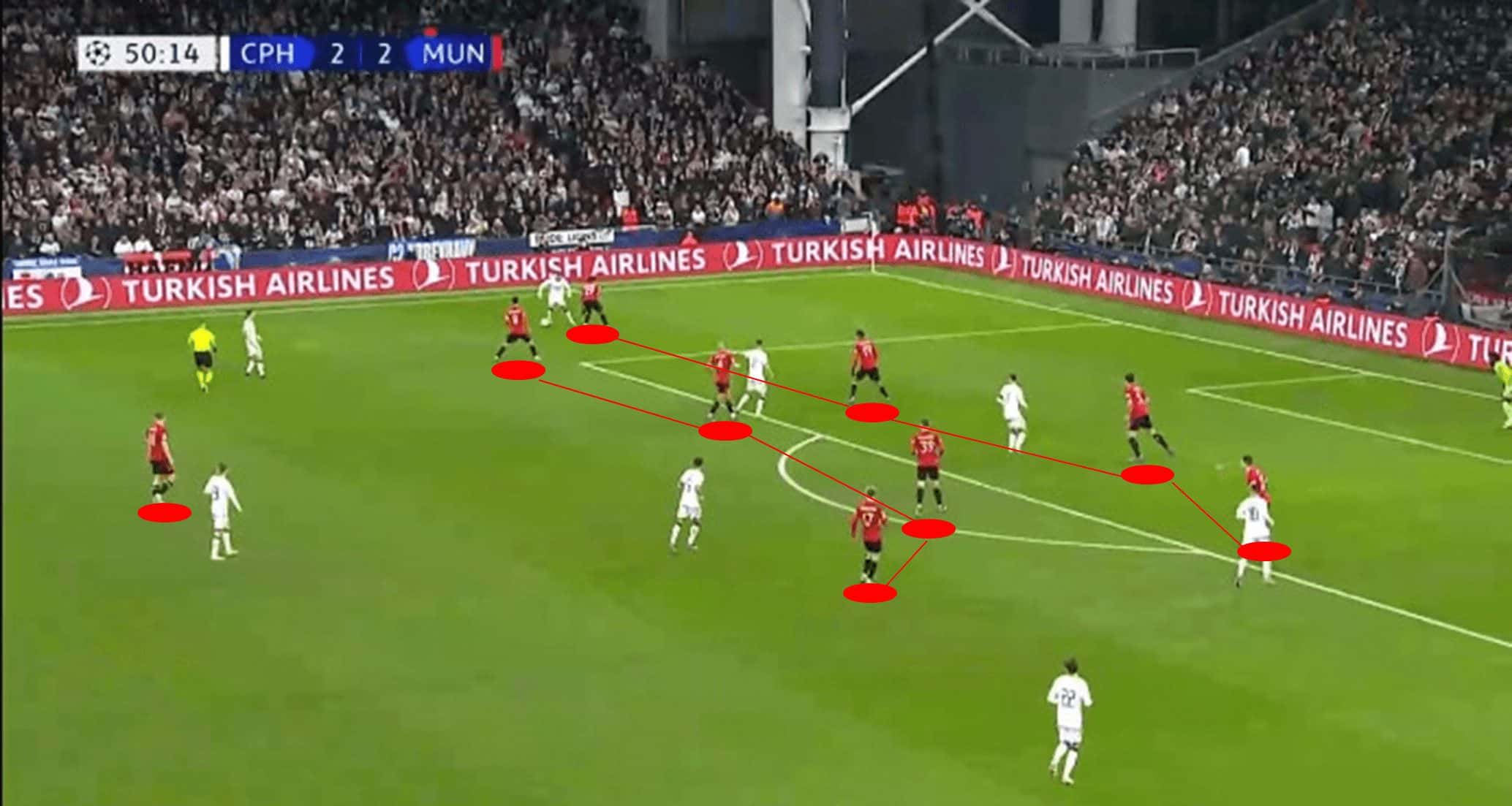
The above image shows the 4-4-1 setup without possession that United adopted. Alejandro Garnacho is positioned slightly advanced in the midfield four, ready to link up with Højlund and utilise his pace if the opportunity arose.
Although United used a solitary striker, they were still able to make opportunities and use Højlund’s hold-up play to their advantage.
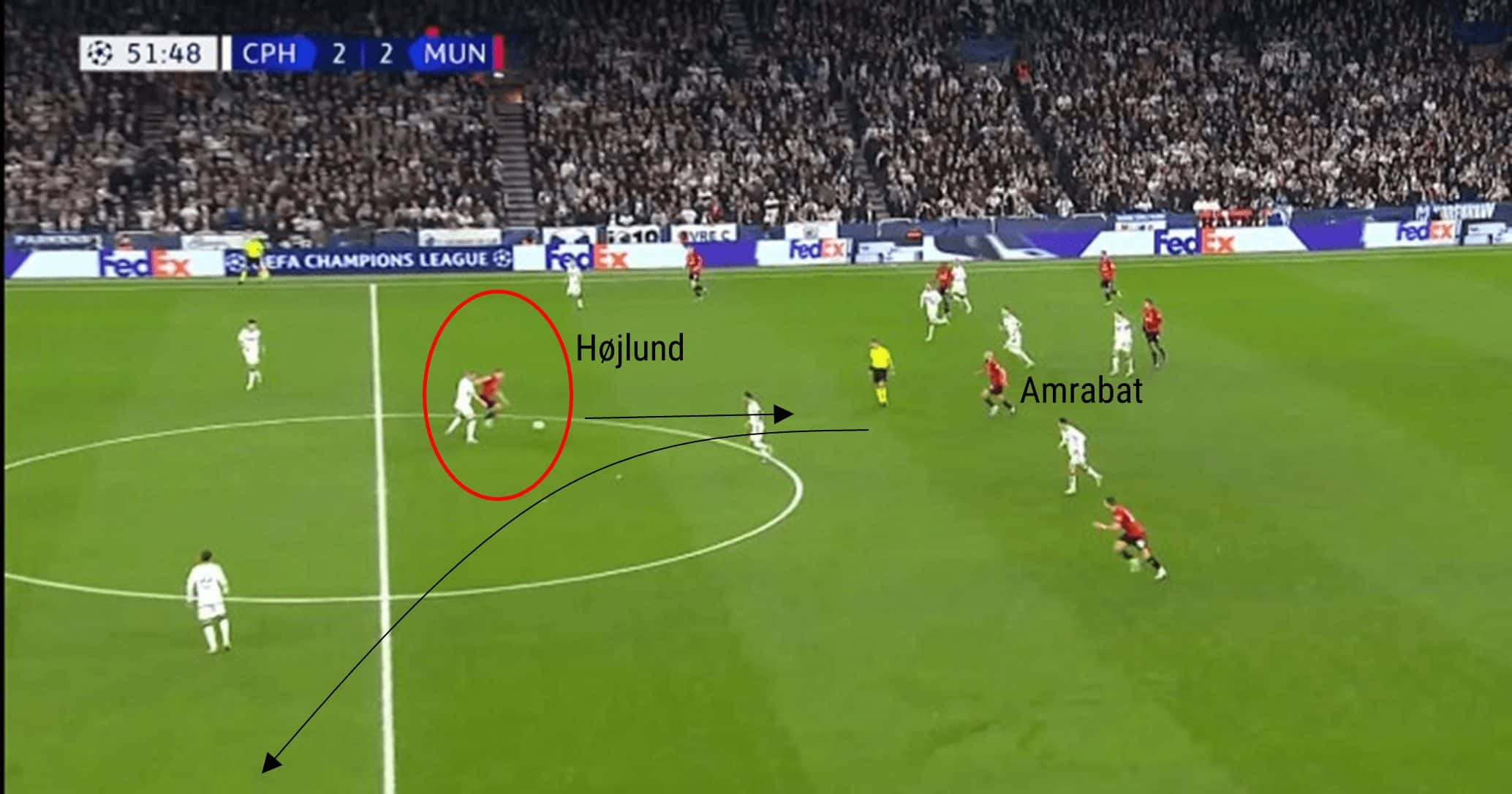
The young Danish forward is seen here holding the play up and uses his strength to hold off the Copenhagen defender before laying the ball off to Sofyan Amrabat. Amrabat then immediately switches the ball out wide to Garnacho.
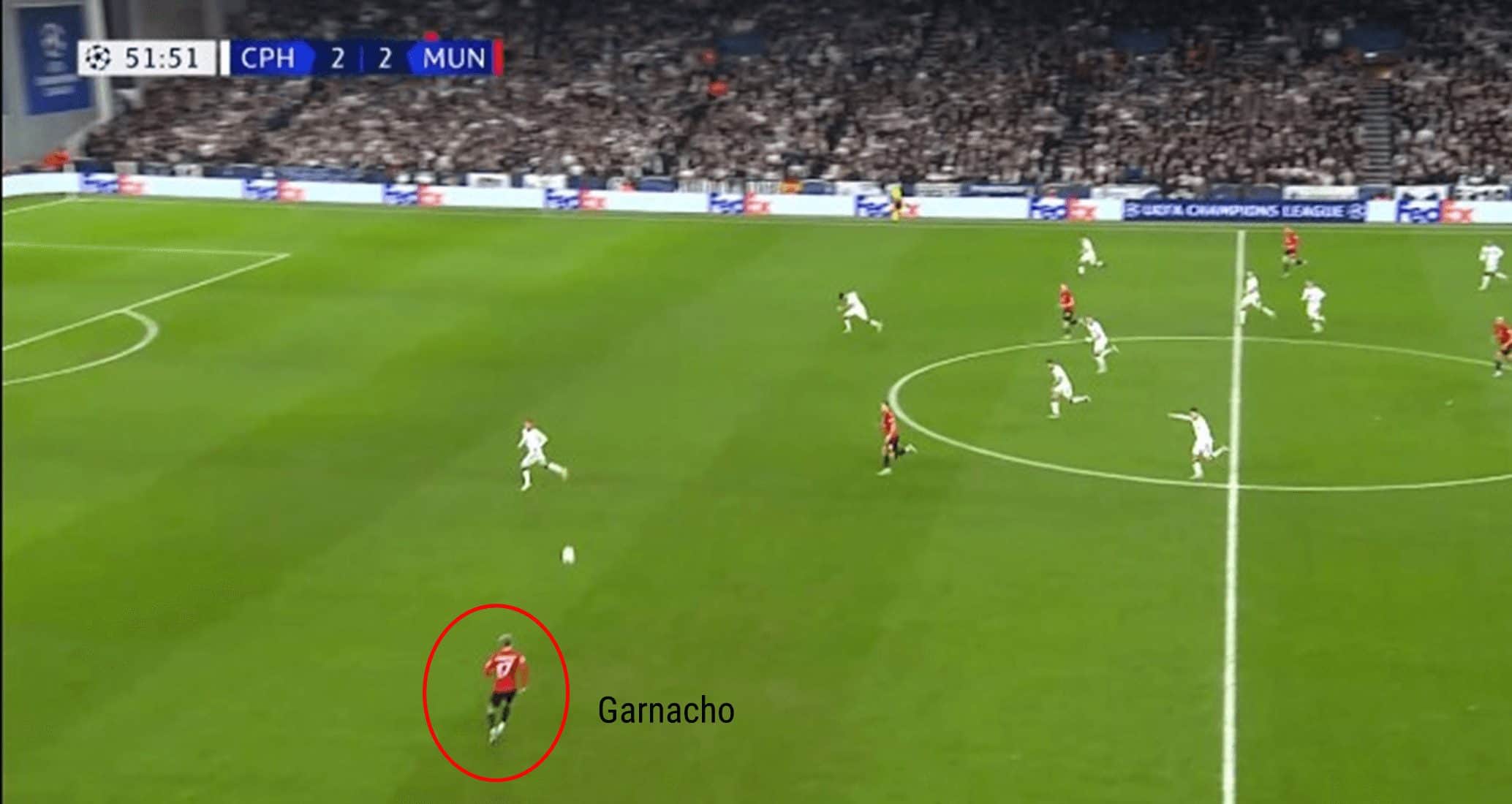
This highlights that using the width of the pitch is particularly important when down to 10 men as it stretches the opposition, as seen above.
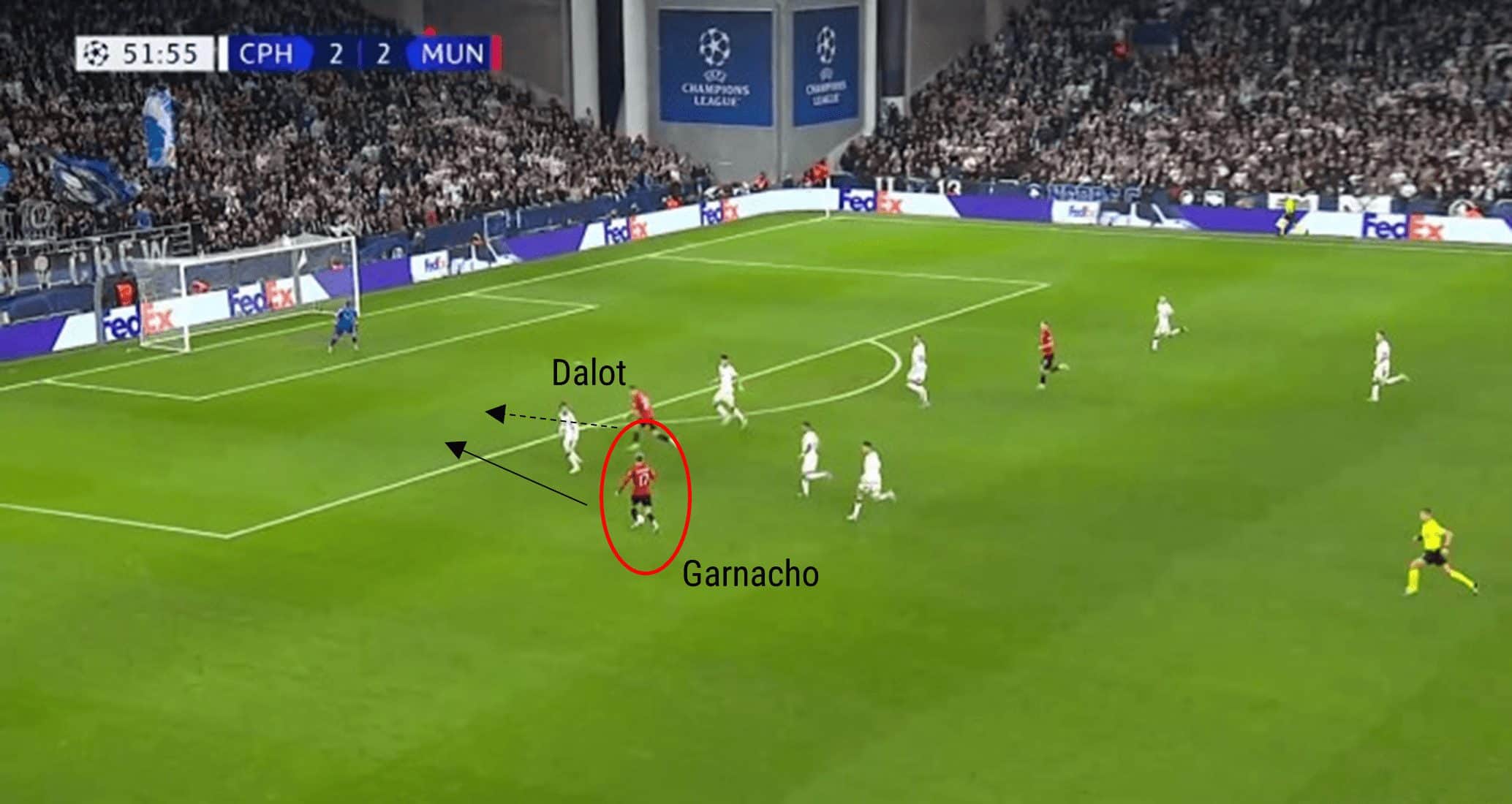
Garnacho advances with the ball and slips it into the advancing Diogo Dalot. Dalot is able to get a shot away but fails to score.
The 4-4-1 formation aided United in intercepting the play deep inside their own half and breaking away. Although Copenhagen equalised to make it 2-2, United did regain the lead despite fewer men on the pitch. Copenhagen equalised again in the 83rd minute, and United appeared content to settle for a point when ten Hag opted to replace Højlund with Mason Mount, who played a false number nine.
However, the switch did not pay off as United struggled to break from their half thereafter. Copenhagen went on to get the winner with three minutes of normal time remaining. It is debatable that they may have come away with a point if Ten Hag decided to keep the young Danish forward on the pitch. This suggests that the consideration of personnel is just as important as the tactics.
Retreating backline
Similarly to Spurs, Liverpool were reduced to nine men in the fixture away at Tottenham. However, in contrast to Tottenham’s approach to Chelsea, Jurgen Klopp instructed his side to play much deeper than normal.
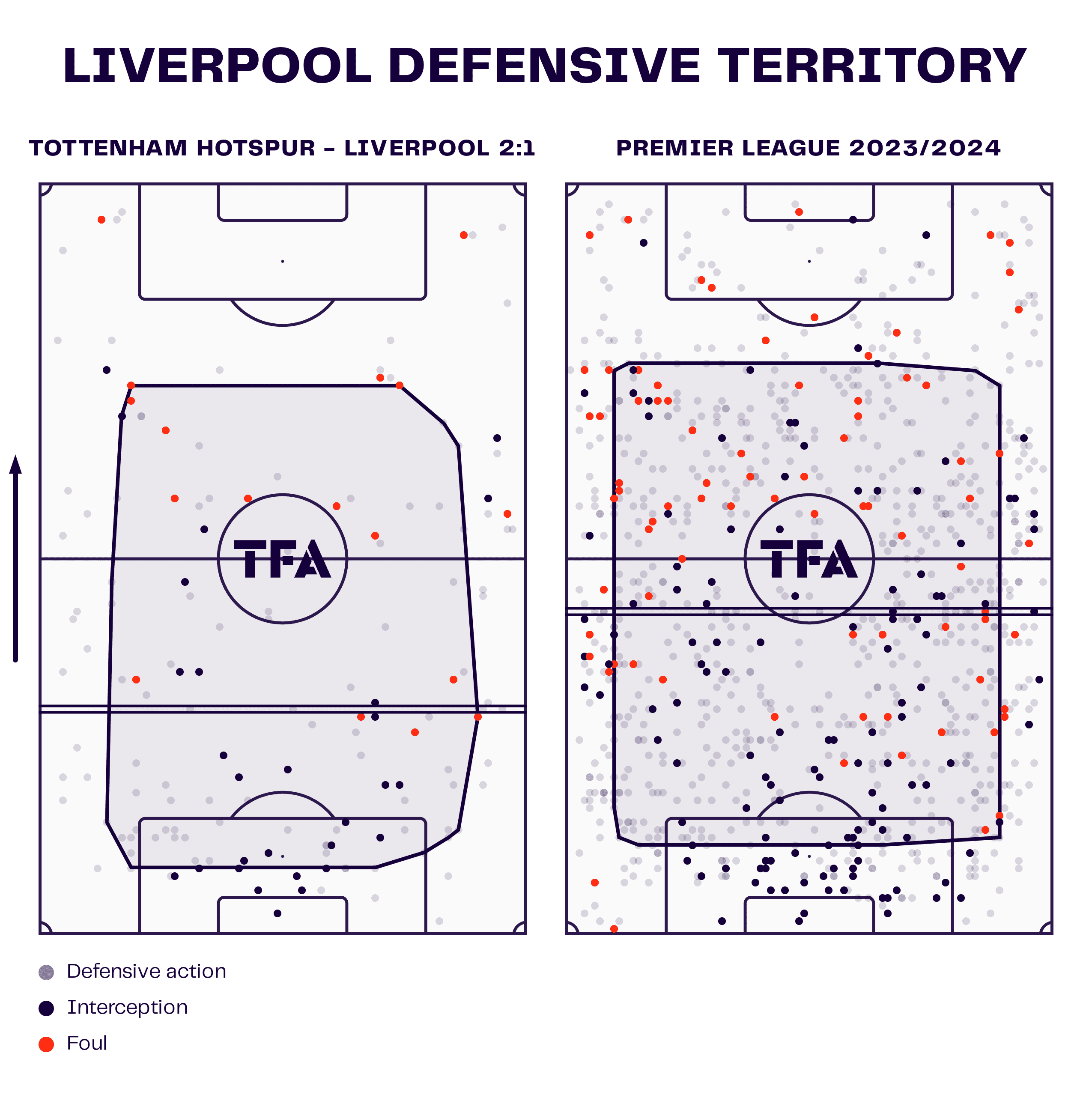
The graphic shows that in the game against Spurs, Liverpool adopted a much deeper defensive line than the average Premier League match they have contested this season.
When the Merseyside club were down to 10 men, however, they posed more of an attacking threat and managed to equalise as well as have an effort ruled out controversially for offside.
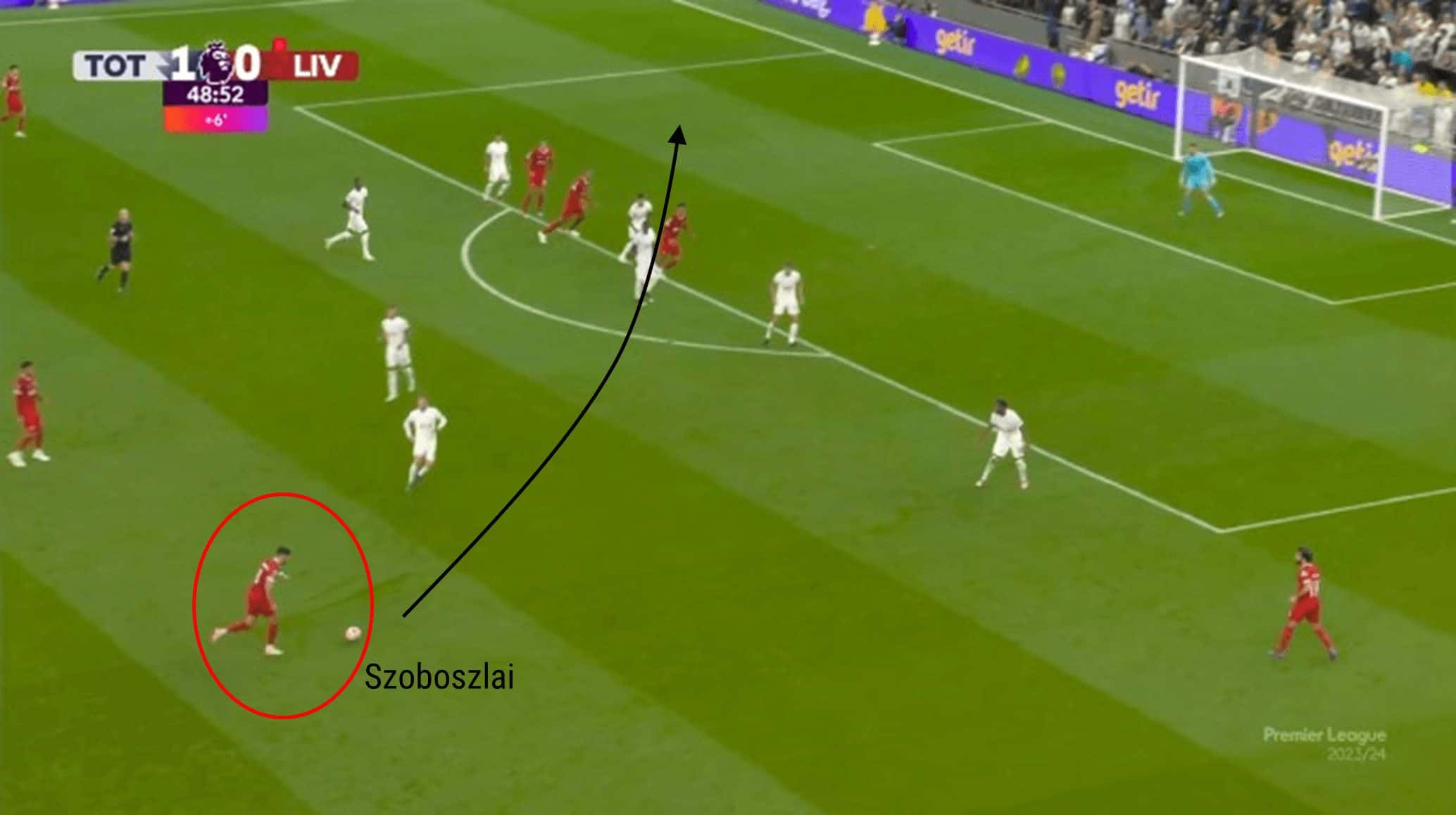
Following a set piece, Liverpool used the opportunity to keep players near the box. Dominik Szoboszlai lifted a ball into the area.
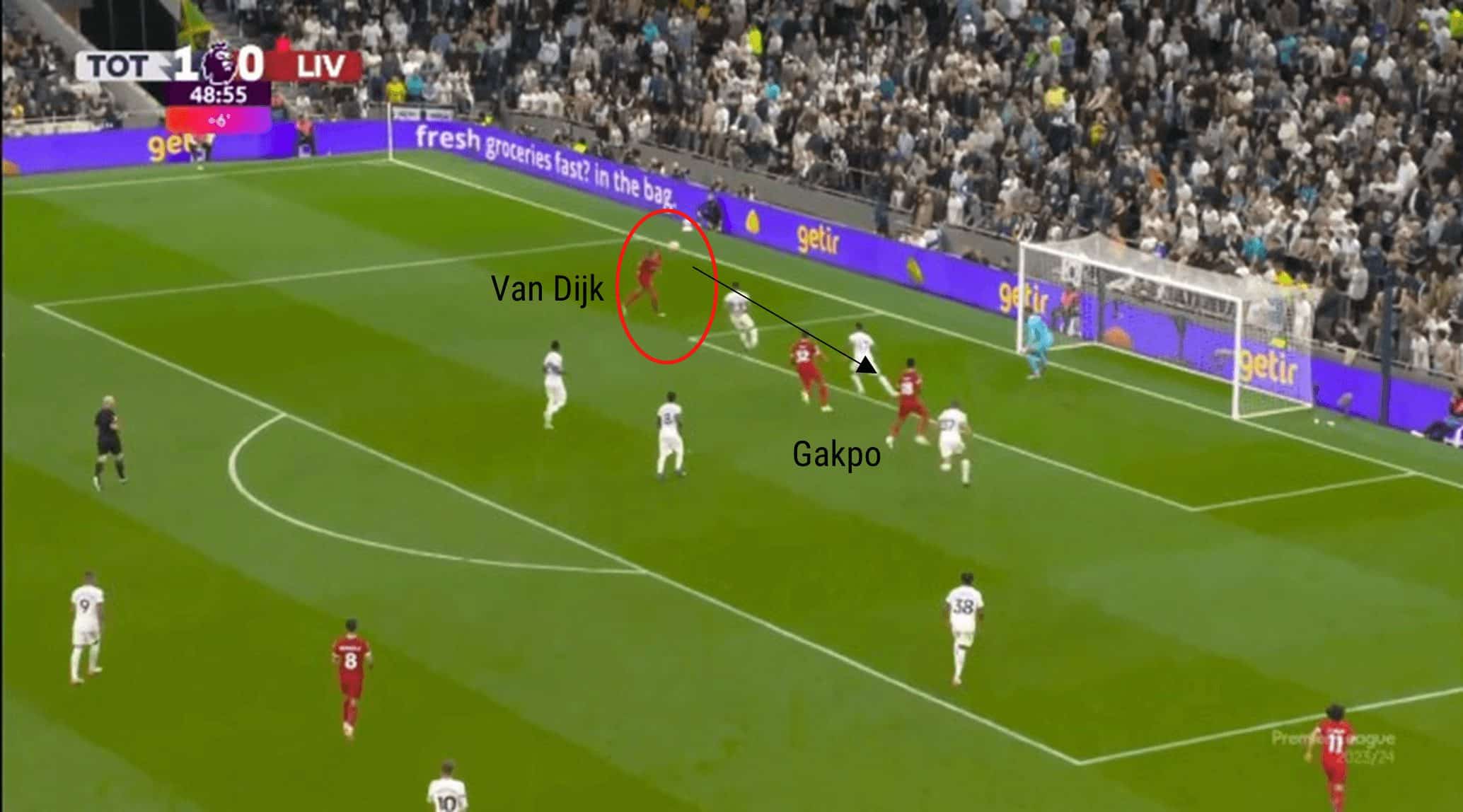
Virgil Van Dijk headed across the penalty area towards Cody Gakpo, who turned and subsequently levelled the scores.
As the match progressed, Liverpool looked to catch Spurs on the counterattack.
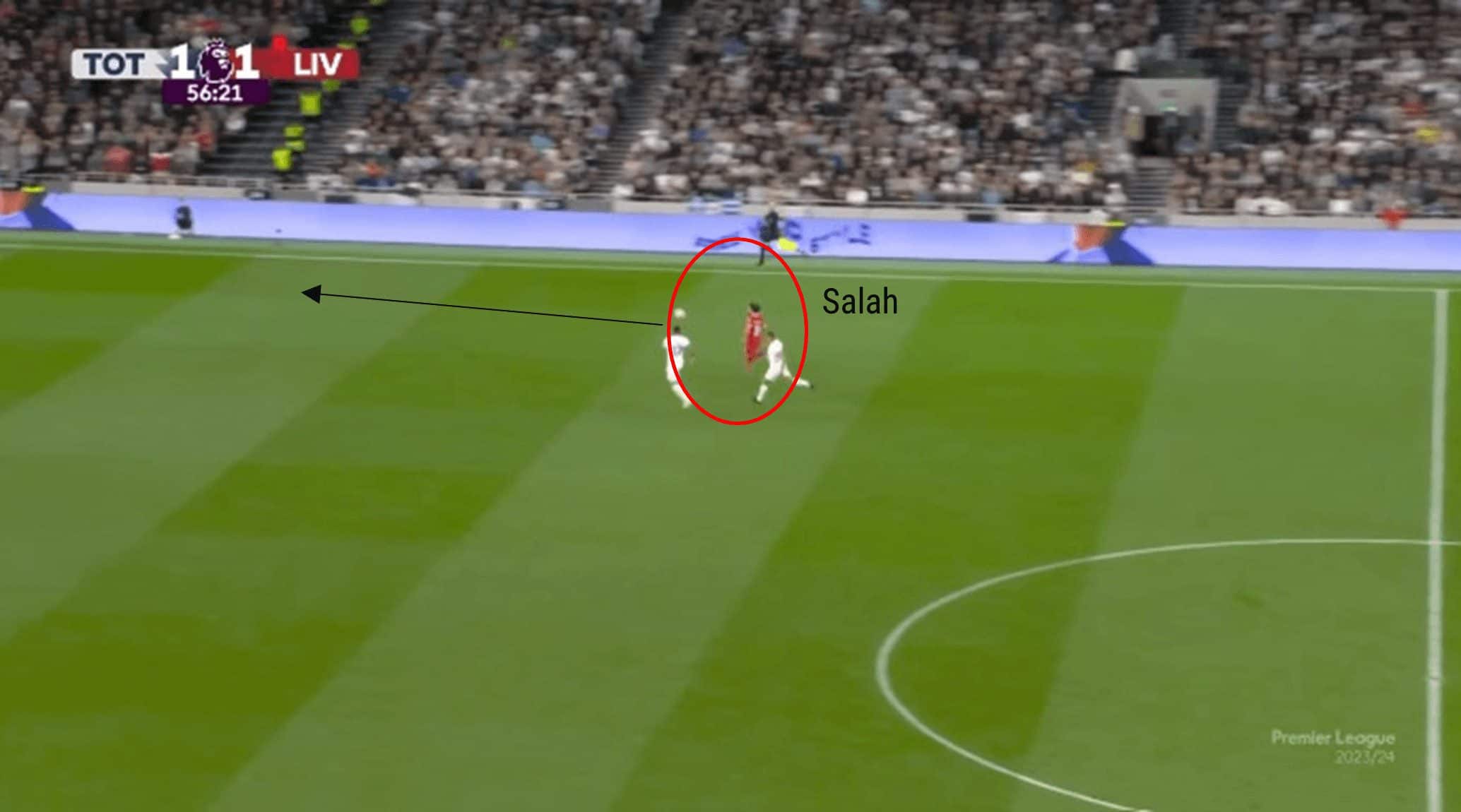
Once Alisson had caught the ball, he quickly distributed it to Mo Salah, who had been left further up the pitch. Salah used his pace to advance the play but was subsequently tackled. The Egyptian did, however, win a throw-in for his side deep in the Spurs half.
The counterattack is a useful tactic, when not predictable, to advance the attacking phase of play and relieve pressure on your own team. It is a tactic best utilised when pace is present in the forward line, and Liverpool used this tactic to good effect in this instance.
When Liverpool were reduced to nine men, the deep defensive line, as seen below, ensured they sacrificed their attacking threat as they only recorded two shots following Diogo Jota’s second yellow card.
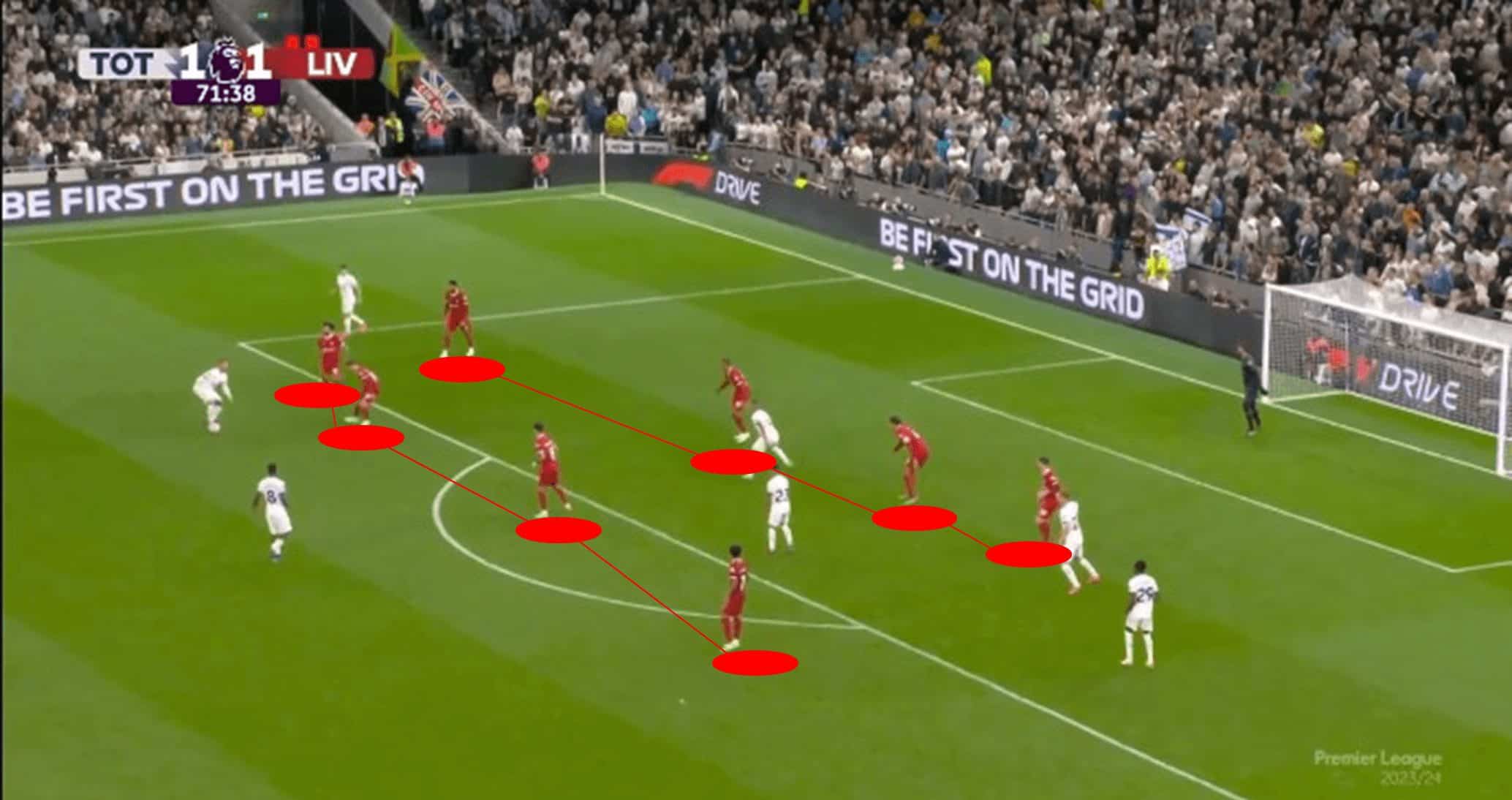
The Reds nearly hung on for a hard-fought point but suffered defeat as a consequence of Joel Matip’s own goal. The disadvantage of playing so deep is that it invites the opposition to continually apply pressure, and Liverpool subsequently succumbed to such pressure.
On the other hand, there is a notion in football that playing against 10 men can be more difficult than playing against 11. This is something Sunderland discovered in their 0-0 draw away at Swansea in the EFL Championship.
Swansea had 30% possession in the match and rooted themselves in their half to nullify Sunderland following Charlie Patino’s dismissal on the half-hour mark.
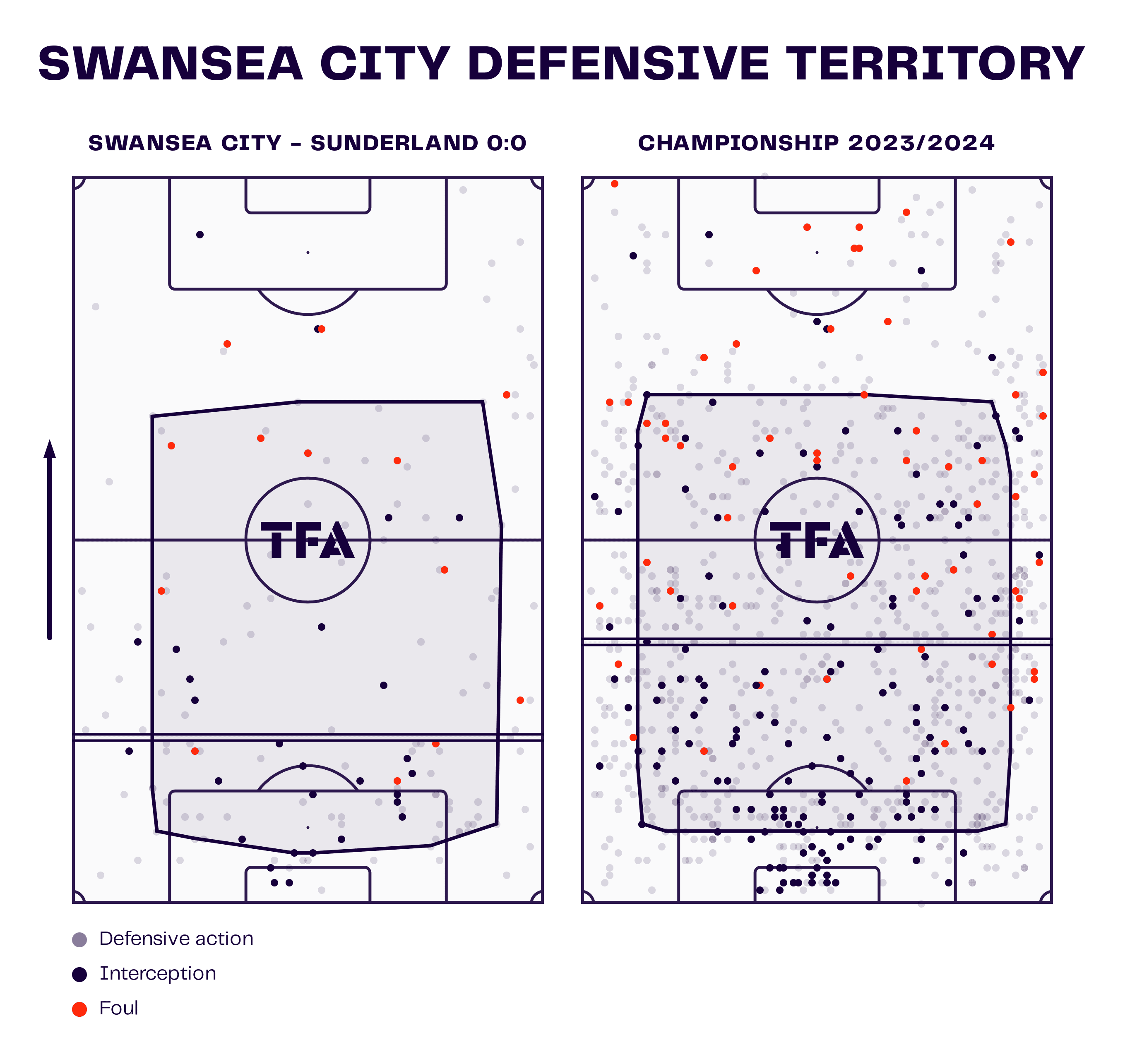
The graphic shows how, like Liverpool, Swansea adopted a deep backline on the edge of their penalty area. This deep defensive line was much deeper than their average line in the Championship this season. However, the Black Cats struggled to break down the Swansea backline.
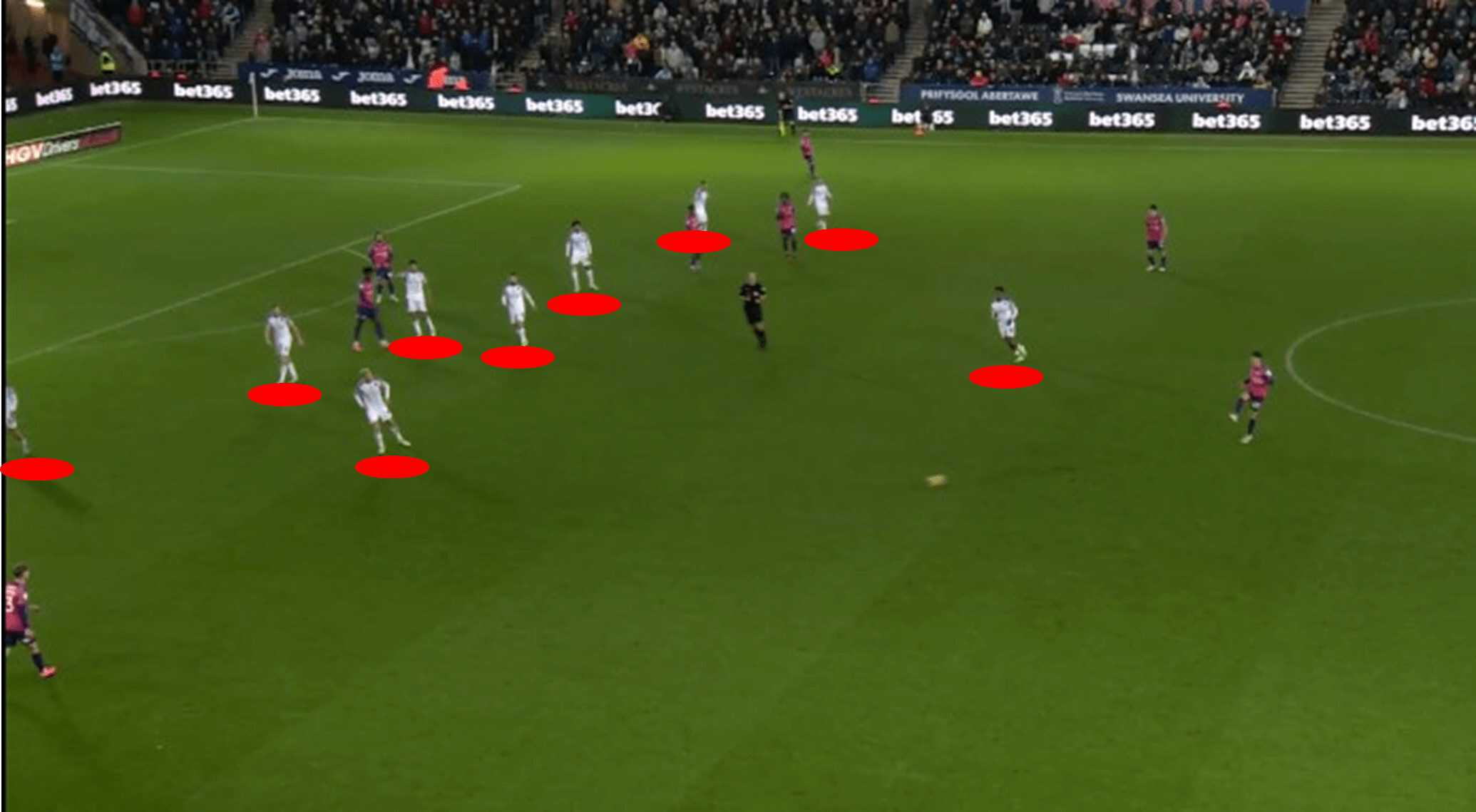
The images show how deep Swansea played with 10 men and put the impetus on Sunderland to break them down. Sunderland like to play possession-based football and have averaged 57.8% possession per game in the league this campaign, the third highest in the division. However, the Wearsiders opted to utilise an aerial threat in an attempt to break Swansea’s defence.
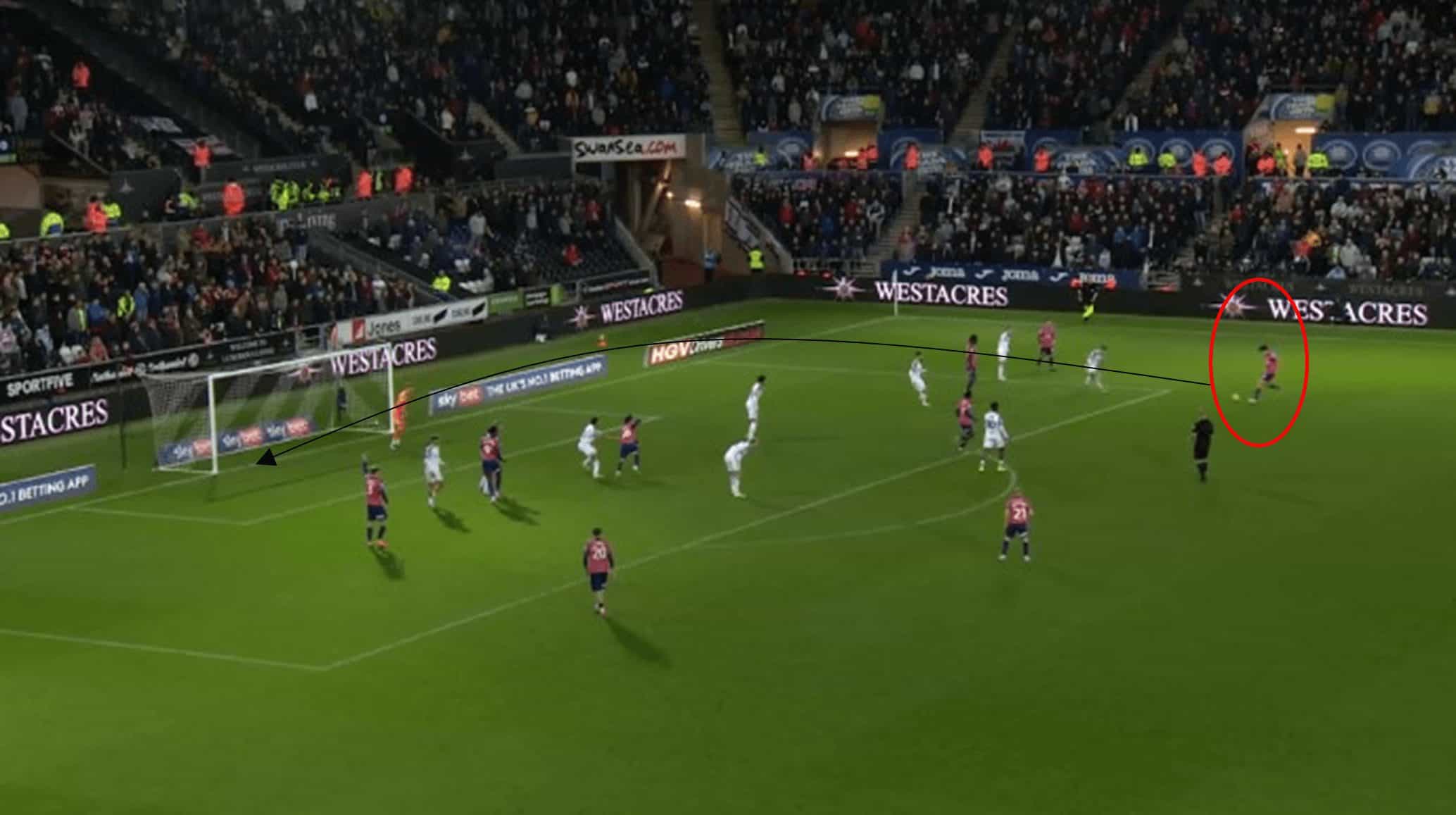
The Black Cats were forced to put crosses into the area as Swansea congested the pitch, making it difficult for Sunderland to find space. Although Sunderland had a man free at the back post here, he was unable to connect with the ball, and Swansea won a goal kick.
Tony Mowbray’s side created more clear-cut opportunities against a full Swansea 11.
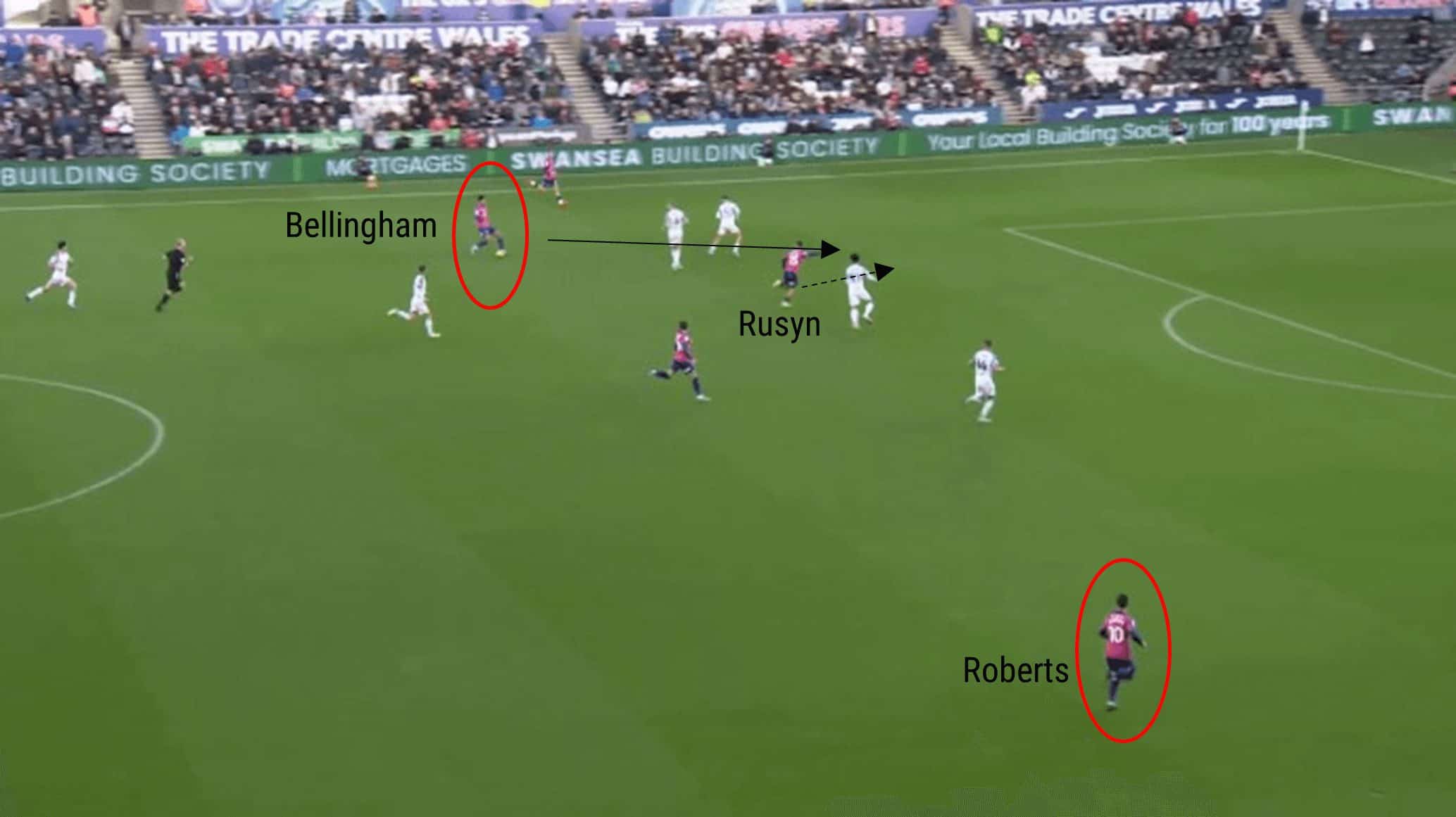
Although Rusyn’s effort is off-target, Jobe Bellingham is playing a through ball here for Nazariy Rusyn. It is further noticeable in the image how much space Patrick Roberts has on the right-hand side. This was a common theme of this match prior to the red card.
It has been demonstrated that Sunderland were able to create promising chances in the early stages against Swansea. They may have arguably emerged as the winners had Swansea not been reduced to 10 men. Swansea’s tactics proved that, on occasions, adopting a retreating backline can have its advantages, but it may depend on whether the opposition’s playing style is successful.
Conclusion
In this tactical analysis, we have seen different approaches adopted by different teams when given red cards and assessed the advantages and disadvantages of the strategies. Union Berlin showed the importance of changing tact in and out of possession, particularly the benefits of utilising the width of the pitch. Moreover, the Germans’ play highlighted how valuable set pieces are when having fewer players on the pitch.
This analysis has shown that a deep defensive line with a numerical disadvantage can be a negative in that it keeps inviting the opposition to apply pressure, suggesting it can be difficult to play so deep if plenty of the game remains. On the other hand, Swansea proved that depending on the opposition’s usual style of play, there can be merits to playing so deep.
Postecoglou’s philosophy has undoubtedly led to debate on changing tactics during a match due to dismissals. Despite opting for a seemingly mad approach, Tottenham almost clinched something from the recent London derby. Would Spurs’ fixture against Chelsea have been half as memorable if he hadn’t instructed the high line? Quite possibly not.






Comments